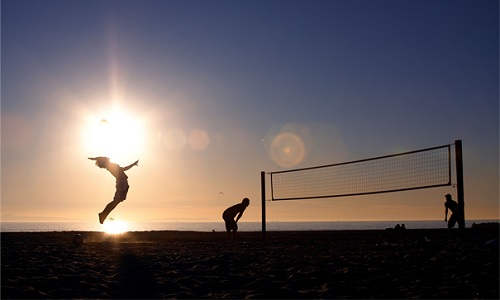First developed as a sport at the beaches of Hawaii and California in the early 20th century, beach volleyball was not played in an organised form until the 1970s, and was mainly practiced by surfers and vacationers. In the 1980s beach volleyball was popularised in Brazil which gave the sport and its governing body – the FIVB – the all-needed leverage to promote and commercialise beach volley internationally. As a result, beach volleyball entered the Olympic programme as a trial sport in 1996 and has remained there since. Not only that, but beach volleyball is considered one of the fastest-growing Olympic sports in the past 15 years. Its growth, however, is not only constrained to the Olympic movement.
Beach volleyball first entered NCAA’s programme as an emerging sport back in 2009 under the name of sand volleyball. Now known as beach volleyball, the sport will have its own NCAA Championship starting in the spring of 2016. It is no surprise that it took beach volleyball less than seven years to achieve this status in the US. It is officially the fastest-growing sport in the NCAA programme with 50 higher educational institutions sponsoring it this year. What is even more significant, however, is that the majority of the players from the sponsoring institutions take part only in the beach version of volleyball and not the indoor one.
According to statista.com the number of Americans participating in beach volleyball has risen from 3.32 million in 2006 to 5.14 million in 2012. Conversely, the figures for indoor volleyball participation from 2006 to 2012 have remained steady, and even decreased – from 8.19 million participants in 2008, the number dropped to 5.98 million participants in 2011, before bouncing back to over 6 million in 2013. Total volleyball participation is also declining in England (from 32,700 people in 2006 to 26,600 in 2015) but beach volleyball participation is on the rise. Beach volley is becoming increasingly popular in Australia and New Zealand, as well as in continental Europe.
Beach volley is not only popular amongst participants. During the Beijing Olympics, it was the sport with the most hours of air time in the United States, getting prime-time coverage on NBC. It is true that this was largely due to the success of the American pairs, but they only won 2 gold medals from the 36 gold and 110 overall medals the country managed to collect. During London 2012, the beach volleyball women’s semi-finals, together with the gymnastics final event drew the largest Olympic TV audience in the States since the Montreal Games in 1976.
Despite its success, beach volleyball still remains, with few exceptions, a sport mainly played within affluent areas and regions of the world. This is less because of the costs associated with participation (which are significantly lower than most other sports), but more due to the culture associated with the sport. Beach volleyball is part of the group of lifestyle sports, together with skateboarding, snowboarding, freestyle skiing, and bmx racing, among others. The people taking part in such sports are mostly young, well-off members of the higher social classes with a lot of free leisure time. In recent years, however, the growth and popularity of the sport opened it to other audiences and participants. Older people are now taking part more often and in higher numbers and more beach courts are built in mainland areas, far away from any coasts.
There could be many reasons for this surge of the sport’s popularity. One may be that the sport is considered as social and inclusive, unlike some competitive and exclusive sports which put people off. The atmosphere and environment can be another aspect of it – beach volleyball is often accompanied by good weather, music and barbeque. Moreover, because it is harder to move on the sand than indoors, the sand reduces the inequalities between participants’ athleticism, movement skills and physical strength, so older people can play almost on a level basis with younger adults.
Once regarded as the little brother of indoor volleyball, beach volley has now grown up and, in a few years’ time, it may start to challenge its big brother’s position in the sporting family. Whether it will overthrow indoor volleyball as the most popular form of the sport is questionable. Nevertheless, it should, and probably will, receive the recognition it deserves.
Photo Source: Pinterest.





